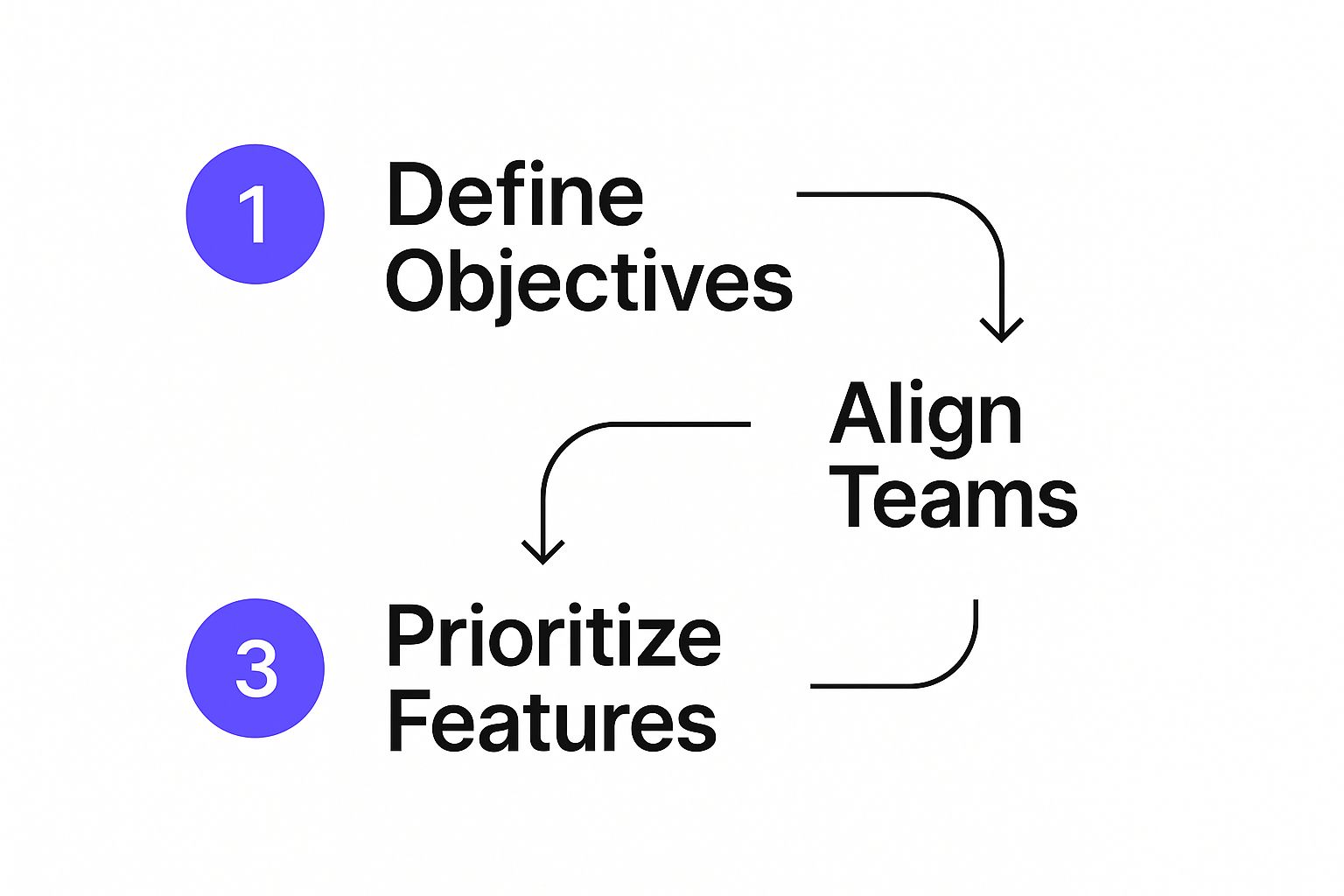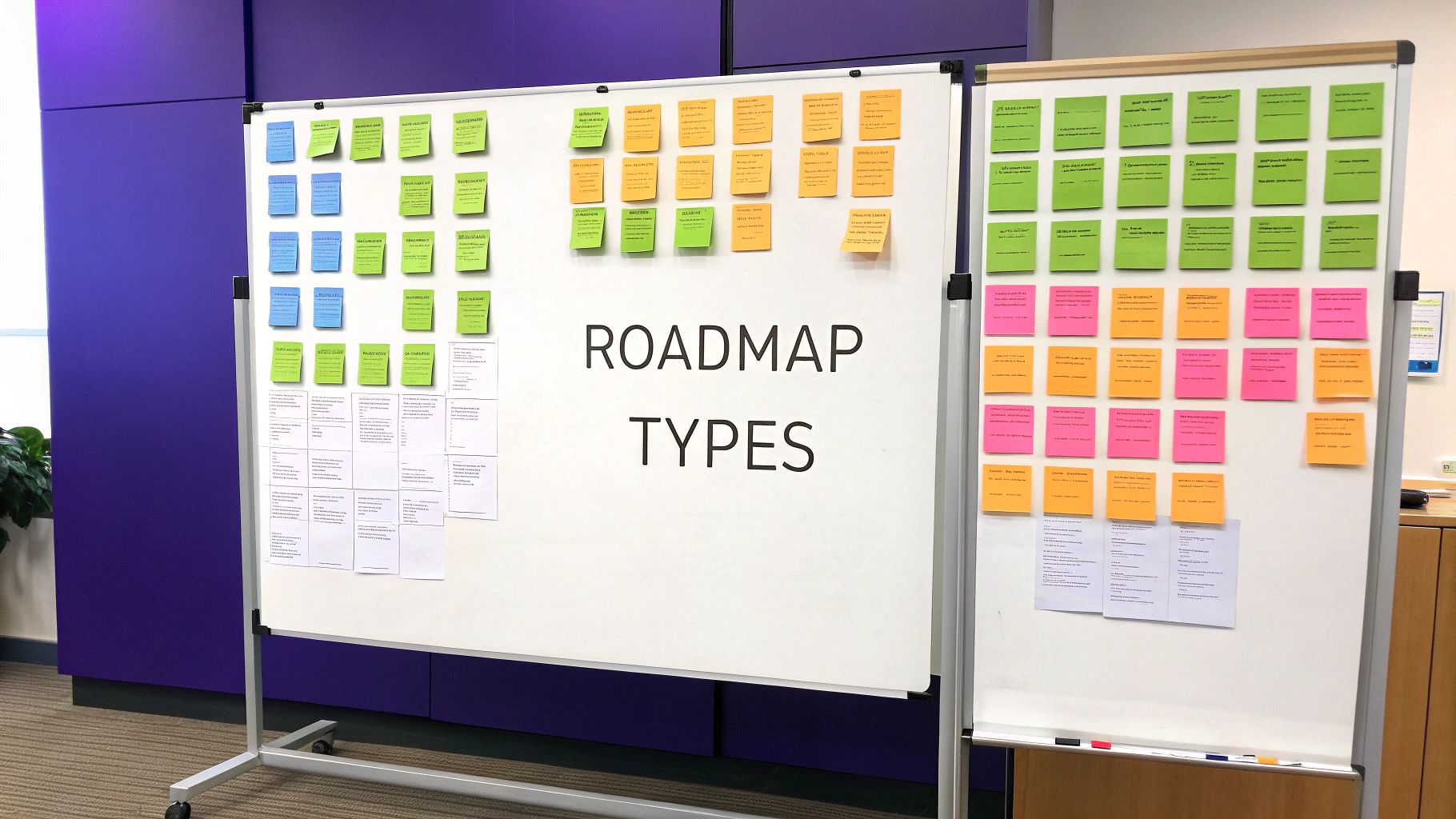If you've ever tried to manage a product's future using a sprawling spreadsheet or a deck of slides, you know the frustration. It's a constant battle with outdated information, misaligned teams, and missed deadlines. A great product roadmap template isn't just another document for tracking features. It's a strategic communication tool—a story about where your product is going and why. It's the key to moving from reactive chaos to strategic clarity.

Why Most Product Roadmaps Fall Short
Let’s get real. A lot of what people call a "roadmap" is really just a glorified feature list. It's usually cobbled together in a tool that was never meant for the job, like that Excel file with a million tabs or a rigid PowerPoint that's obsolete the second you save it.
These static documents don't just get old; they actively create confusion. They turn what should be an alignment tool into a source of debate, making stakeholder meetings feel like a constant battle over timelines and priorities.
The Problem With Static, Lifeless Roadmaps
When your roadmap is just a static artifact, it fails to capture the why behind the work. This disconnect is where the real problems start. Instead of being a north star for the team, the roadmap becomes a bottleneck that slows everyone down.
You're probably feeling this pain if you recognize any of these symptoms:
- Constant Misalignment: Different teams are working in their own little worlds, completely unsure how their daily tasks connect to the company's bigger goals. You find out marketing is planning a huge launch for a feature that engineering quietly pushed back months ago.
- Reactive Fire-Fighting: Without a clear strategic framework, decisions are made based on who shouts the loudest. The team ends up chasing the latest shiny object or catering to a single squeaky-wheel customer instead of delivering real, widespread value.
- Confused Stakeholders: When leaders and investors look at a long list of features without any context, they can't see the connection to business goals. This makes it incredibly hard to earn their trust and secure the resources you actually need.
The biggest flaw in a static roadmap is that it presents decisions as final. A truly effective product roadmap is a living document, built to adapt as you learn and to spark strategic conversations, not shut them down.
From Feature List to Strategic Guide
An effective product roadmap template fixes these issues by fundamentally changing the conversation. It shifts the focus from outputs (what features are we building?) to outcomes (what customer and business goals are we trying to achieve?).
This makes the roadmap a single source of truth that clearly shows how the team's day-to-day work rolls up to high-level strategic themes. It also helps break the cycle of endless debate—a common challenge we cover in our guide on how to overcome analysis paralysis.
When every initiative is tied to a clear objective, you empower your team to make smarter decisions on their own. Your roadmap transforms from a document of empty promises into a powerful tool that drives real alignment and progress.
Ground Your Roadmap in Strategic Themes
A long list of features isn't a strategy. Before you even start plugging items into your roadmap template, you have to answer the most important question: why are we building this? The answer lies in your high-level strategic themes.
Think of these themes as the glue connecting your company's big-picture business goals to the day-to-day work your team is doing. They turn a simple to-do list into a story that everyone, from engineering to sales, can get behind.
For instance, "Improve User Login" is a task. But "Streamline New User Activation" is a strategic theme. See the difference? The focus immediately shifts from a technical chore to a clear business outcome, making the purpose obvious to everyone involved.
Translating Goals into Actionable Themes
So, where do you start? Look at what your organization wants to achieve this quarter or this year. Is the big push to crack a new market? Maybe the focus is on cutting customer churn by 15% or simply making internal operations run smoother.
Each of these goals can be directly translated into a product theme that guides your work.
-
Business Goal: Capture a new market segment (like enterprise customers).
-
Product Theme: "Develop Enterprise-Grade Security & Compliance."
-
Business Goal: Increase user retention.
-
Product Theme: "Enhance Core Product Stickiness."
This flow—from broad objectives down to the specific features on your roadmap—is crucial.

As you can see, you have to get your objectives straight and your teams aligned before you start prioritizing features. This ensures every decision is driven by strategy, not just the latest request. This structure is also your best friend for communicating the plan and setting expectations everyone can agree on. Tools like Aha.io offer guided templates that can help build these visuals and get your team on the same page.
A theme-based roadmap forces you to have the right conversations. When a stakeholder asks for a new feature, the first question is no longer "When can we build it?" but "Which strategic theme does this support?"
Aligning Your Team Around the "Why"
When you anchor your roadmap in themes, you give your entire organization the clarity it needs to make smart decisions. Engineers can design better, more scalable architecture because they understand the long-term vision. Marketing and sales can build powerful narratives because they know exactly which customer problems you're setting out to solve. If you want to go deeper, exploring different product strategy frameworks can really help lock this process in.
This is where a good roadmap template becomes invaluable. It helps you organize all the work—from managing new ideas to detailing features and planning releases—around those core strategic objectives.
As you build this out, don't be afraid to explore different ways to visualize your plan. One popular and effective approach is the Now Next Later Roadmap. It helps you prioritize what's important without getting trapped by rigid, often arbitrary, deadlines. The focus stays squarely on delivering value, not just hitting dates on a calendar.
By starting with themes, you create a direct line from every single feature, update, and bug fix back to a meaningful business goal. That strategic foundation is what makes a roadmap a true guide to success, rather than a document that just gathers dust.
Tailor Your Roadmap for Every Audience

Here’s a hard truth I learned early on: a one-size-fits-all product roadmap just doesn't work. The super-detailed, granular view that your engineering team needs to plan their sprints will make an executive’s eyes glaze over in about thirty seconds. On the flip side, the high-level strategic overview you show the board is completely useless for your design team.
This is where a well-designed product roadmap template becomes your secret weapon. The goal isn't to create and maintain multiple, conflicting roadmaps—that's a recipe for disaster. Instead, you create a single source of truth that can be filtered and adapted for each specific audience. Everyone gets the information they need, in a format they can actually use, without creating a ton of confusion.
Creating Strategic Views for Leadership
Let's start at the top. Your executive team and key stakeholders live at the 30,000-foot level. They don't care about individual user stories or technical dependencies. They need to see a straight line connecting product initiatives to the company's big-picture business goals and key performance indicators (KPIs).
For this audience, you need a view that highlights:
- Strategic Themes: Bundle initiatives under broad goals, like "Increase Q3 User Retention" or "Expand into New European Markets."
- Business Outcomes: Get specific about the why. What's the expected result? A 10% reduction in churn? Capturing 5% of a new market segment?
- High-Level Timelines: Ditch the specific release dates. Think in broader strokes like quarters or even a simple "Now, Next, Later" format.
This strategic view turns your roadmap from a simple plan into a powerful communication tool. It’s how you get buy-in and secure resources, because you’re telling a clear story about how product development is directly driving business success.
Providing Tactical Clarity for Development Teams
Now, let's zoom in. Your engineering, design, and UX teams are the ones in the trenches, and they need the details. They're focused on execution, so they need a tactical view that gives them absolute clarity on what to build, when to build it, and how it all connects.
The view you create for your internal teams should be filterable to show:
- Specific Features and Epics: These should link directly back to items in your project management tool, like Jira or Asana.
- Dependencies: Make it obvious which tasks are blocking others. This is critical for preventing bottlenecks down the road.
- Sprint-Level Detail: Show exactly what the team is committing to in the immediate future.
- Status Updates: Everyone should be able to see real-time progress, whether something is "In Discovery," "In Development," or "Ready for QA."
This level of detail is what empowers your team to plan effectively and stay focused. It cuts through the ambiguity and ensures that the day-to-day work never loses sight of the bigger picture, which is absolutely vital when you need to prioritize product features effectively.
A great roadmap doesn't just present a plan; it facilitates a conversation. By tailoring the view, you ensure every conversation is relevant, productive, and focused on what matters most to that specific audience.
Communicating Progress to Sales and Marketing
Finally, you have your go-to-market teams—sales, marketing, and customer support. They have their own unique set of needs. They need just enough information to prepare for launches and communicate value to customers, but the deep technical stuff is just noise to them.
For these teams, create a view that zeroes in on:
- Upcoming Feature Launches: Frame everything around the customer-facing benefits and the problems you’re solving for them.
- Target Release Windows: Give them general timelines (e.g., "Late Q4") so they can get a head start on planning campaigns and preparing materials.
- Key Messaging Points: Include a few bullet points on the value proposition for each major release. This is gold for the marketing team.
This customized view ensures your entire organization is rowing in the same direction. It transforms your roadmap template from a static planning document into a dynamic hub for true cross-functional alignment.
Find the Right Tools to Bring Your Roadmaps to Life
A product roadmap template is only as good as the tool you use to build and manage it. Let's be honest, a static spreadsheet or a slide deck is a recipe for disaster. It becomes outdated the moment you save it, causing more confusion than it clears up. The right software, on the other hand, can turn your roadmap from a dusty document into a living, breathing hub for your entire team.
Modern roadmapping platforms are so much more than just timelines. They’re built to handle the messy reality of product development, helping you see dependencies, share progress, and pivot when things inevitably change. The trick is finding a tool that actually fits the way your team works.
From Static Plans to Interactive Hubs
Choosing the right software isn’t about ticking off the most features. It's about solving your biggest communication and alignment headaches. Some teams need a flexible, visual canvas to throw ideas around, while others work better with the guardrails of a dedicated product management suite.
Think about where your team gets stuck most often:
- Visualizing Dependencies: Are you constantly running into unexpected blockers? Tools that map out dependencies can save you a world of hurt.
- Stakeholder Communication: Do you struggle to get execs to see the big picture? Look for a tool that can create high-level, theme-based views they can actually understand.
- Real-Time Collaboration: Is your team distributed across different time zones? A platform with live editing and commenting is non-negotiable for keeping everyone on the same page.
Product roadmap templates have become incredibly powerful thanks to AI features and collaborative visual platforms. Miro, for example, has dynamic timelines that make it easy to see how initiatives connect and what depends on what. This is a game-changer when priorities are constantly shifting. You can explore how Miro’s templates can help visualize your timeline to get some ideas.
Here's a great visual example of how you can structure a flexible roadmap.
This screenshot shows how a timeline can organize work by team or theme, giving everyone a clear path forward.
Selecting Your Ideal Toolset
The market is packed with fantastic options, each with its own vibe. Flexible platforms like Mural or Miro are perfect for teams that love to brainstorm and plan visually. Think of them as a massive digital whiteboard where you can map everything out before locking it into a formal plan.
Then you have dedicated product management tools like Productboard or Aha!, which offer a more structured approach. These are built from the ground up for product managers, often including deep features for managing ideas, prioritizing features, and generating different roadmap views for different audiences. The goal is to find something that plugs right into how you already work. For a deeper dive, check out our guide on the best remote product development tools.
The best tool isn't the one with the most bells and whistles. It's the one your team will actually use every day to make better, more informed decisions.
Use Your Roadmap to Unify Your Teams

A product roadmap template is so much more than a planning document. Its real power comes to life when it acts as the central nervous system for your entire organization. Think of it as the tool that transforms siloed departments into a single, cohesive unit, all pushing toward the same goals.
Without that kind of alignment, even the most brilliant strategy will stumble.
The goal is to stop people from seeing the roadmap as a static plan owned by the product manager. Instead, it should be a living, breathing document that everyone feels invested in. When the sales team truly gets why a feature is slated for Q3, and engineering sees how their work connects to a big marketing push, you create a powerful sense of shared purpose.
Foster True Cross-Functional Collaboration
A well-structured roadmap is what makes this cross-functional clarity possible. It provides a clear timeline and transparent priorities, which is exactly what you need when different departments are all involved in development.
To really get everyone on the same page, you need platforms that enhance team collaboration during the entire roadmap process. This isn't just about attending another meeting; it's about building an environment where every team's perspective is baked into the plan from the start.
This means you have to move past simple status updates and start having real strategic conversations. A roadmap planning session shouldn't be the product team just presenting their ideas. It needs to be an interactive workshop.
Invite key people from across the company to have a seat at the table:
- Engineering Leads are your reality check. They can tell you what's technically feasible and how much effort it will actually take.
- Marketing Managers bring crucial insights on market timing and how to position a new feature for the biggest impact.
- Sales Reps are on the front lines, bringing back invaluable feedback straight from customers. They ensure you’re solving real problems.
- Designers and UX Researchers are the voice of the user, making sure the "what" you're building is grounded in what customers actually need.
When you take this kind of inclusive approach, the roadmap becomes something everyone helped create. That buy-in is priceless.
Communicate Changes Transparently and Effectively
Let’s be real: things change. Market conditions shift, new customer data surfaces, and unexpected technical hurdles pop up. The difference between a high-performing team and a frustrated one is how you communicate those changes. Your roadmap should be the main tool for this.
A roadmap is a statement of intent, not a blood oath. The goal isn’t to stick to the plan no matter what; it’s to adapt intelligently and ensure everyone understands the rationale behind the pivot.
When a timeline slips or a feature gets reprioritized, don't just quietly update the document and cross your fingers. Be proactive. Be transparent.
Here's a simple way to frame those conversations:
- Acknowledge the Change: Start by clearly stating what's different from the original plan.
- Explain the "Why": Give them the context. Did new customer feedback come in? Did a competitor make a move? Did you discover a technical roadblock?
- Outline the Impact: Walk through how this shift affects other teams and the overall timeline. No surprises.
This level of transparency builds incredible trust and resilience. It shows your teams that decisions are strategic, not just random. For distributed teams, having the right systems is key; our guide on https://www.remotesparks.com/collaboration-tools-for-remote-teams/ can help you build a solid communication stack.
By using your roadmap as the anchor for these tough conversations, you make sure that even when the plan changes, the team stays perfectly aligned.
Common Questions About Product Roadmaps
Even with a killer template, you're going to have questions. It's just part of the process. Let's tackle some of the most common ones I hear from product managers trying to get their roadmaps right.
How Often Should I Update My Product Roadmap?
Think of your roadmap as a living document, not something you carve into a stone tablet. I recommend a major strategic review every quarter. This is your chance to zoom out and make sure your plan still aligns with the big-picture company goals.
That said, you'll be making smaller tweaks more often. Monthly check-ins are a great rhythm. They give you a chance to react to new customer feedback, fold in what you learned from the last sprint, or respond to a competitor's surprise move. It's all about finding that sweet spot between being agile and creating chaos.
The goal is strategic consistency, not rigid adherence. If you're changing it daily, you'll give your team whiplash. But if you let it gather dust, nobody will trust it.
What’s the Difference Between a Roadmap and a Release Plan?
This one trips a lot of people up, but the distinction is crucial. Here's the simplest way to think about it: the roadmap is your strategic "why," and the release plan is your tactical "how" and "when."
Your product roadmap is the 30,000-foot view. It paints the picture of your strategic direction, focusing on broad themes and the outcomes you're trying to achieve over the next few quarters or even a year. It’s all about communicating the vision.
A release plan, on the other hand, gets into the nitty-gritty. It's a short-term, detailed schedule breaking down the specific user stories, tasks, and deadlines needed to ship the next feature or update. The roadmap sets the destination; the release plan maps out the next few turns.
How Do I Say No to Stakeholder Feature Requests?
Learning to say "no" without alienating everyone is one of the most important skills a PM can develop. When a key stakeholder comes at you with a feature they absolutely must have, your roadmap becomes your best friend.
First, always listen. Don't just hear the feature they're pitching; dig into the problem they're trying to solve. What's the real pain point behind their request?
Once you understand their "why," gently bring the conversation back to the roadmap. Point to the strategic goals and themes everyone has already agreed on. You can say something like, "I see how this could solve X, but our primary focus this quarter is Y, which we all agreed is critical for hitting our revenue target. Shifting focus now would put that at risk."
The final step is to show you value their input. Offer to add their idea to a backlog for future consideration when priorities are re-evaluated. This validates their contribution while protecting your team from getting pulled in a million different directions.
Ready to turn those brainstorming sessions into a roadmap built on solid ideas? Bulby uses AI-powered exercises to help remote teams generate and prioritize real innovation. Stop going in circles in meetings and start building. See what you can create by exploring Bulby today.

